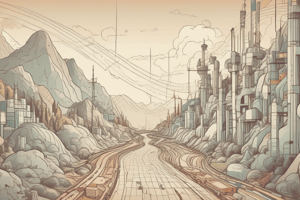Podcast
Questions and Answers
What does a Production Possibility Curve (PPC) graph represent?
What does a Production Possibility Curve (PPC) graph represent?
A PPC graph illustrates the maximum possible combinations of two goods that can be produced with given resources and technology.
What are the assumptions behind a typical Production Possibility Curve (PPC) graph?
What are the assumptions behind a typical Production Possibility Curve (PPC) graph?
The assumptions include: choosing between two goods, given resources and technology, full employment of resources, interchangability of resources between goods, no specific resources for one good only, and considering productive efficiency in physical terms.
How does a shift of resources from one good to another affect production according to the PPC assumptions?
How does a shift of resources from one good to another affect production according to the PPC assumptions?
Shifting resources from one good to another decreases the production of the first good and increases the production of the second good.
What does full employment of resources imply in the context of a PPC graph?
What does full employment of resources imply in the context of a PPC graph?
Why is it assumed that no factor of production is specific to one good in a PPC graph?
Why is it assumed that no factor of production is specific to one good in a PPC graph?
Define the central problems of an economy according to the text.
Define the central problems of an economy according to the text.
How are the production possibilities in a PPC graph determined?
How are the production possibilities in a PPC graph determined?
What is capital formation according to the text?
What is capital formation according to the text?
Explain what technique of production refers to in the context of economics.
Explain what technique of production refers to in the context of economics.
Define merit goods based on the text.
Define merit goods based on the text.
Distinguish between private goods and public goods as per the text.
Distinguish between private goods and public goods as per the text.
Explain the statement 'It will depict reality only if its assumptions are realistic.'
Explain the statement 'It will depict reality only if its assumptions are realistic.'
What is the price elasticity of demand at the midpoint of a linear demand curve?
What is the price elasticity of demand at the midpoint of a linear demand curve?
What is the price elasticity of demand where the demand curve touches the X-axis?
What is the price elasticity of demand where the demand curve touches the X-axis?
What is the price elasticity of demand where the demand curve touches the Y-axis?
What is the price elasticity of demand where the demand curve touches the Y-axis?
For any point between A and C on the demand curve, what is the relationship between price elasticity of demand and 1?
For any point between A and C on the demand curve, what is the relationship between price elasticity of demand and 1?
For any point between B and C on the demand curve, what is the relationship between price elasticity of demand and 1?
For any point between B and C on the demand curve, what is the relationship between price elasticity of demand and 1?
How can we construct a demand curve with unitary price elasticity at all points using the outlay method?
How can we construct a demand curve with unitary price elasticity at all points using the outlay method?
What is the difference between positive economics and normative economics?
What is the difference between positive economics and normative economics?
Distinguish between microeconomics and macroeconomics.
Distinguish between microeconomics and macroeconomics.
What is the difference between stock variables and flow variables in economics?
What is the difference between stock variables and flow variables in economics?
Explain the concept of equilibrium in economics.
Explain the concept of equilibrium in economics.
What is the assumption made in static economic analysis or comparative statics?
What is the assumption made in static economic analysis or comparative statics?
How does dynamic economic analysis differ from static economic analysis?
How does dynamic economic analysis differ from static economic analysis?
What is a demand curve with unitary price elasticity of demand also known as?
What is a demand curve with unitary price elasticity of demand also known as?
What are the three categories that commodities are normally divided into, according to the text?
What are the three categories that commodities are normally divided into, according to the text?
For which category of commodities will the price elasticity of demand be less?
For which category of commodities will the price elasticity of demand be less?
Why does the demand for luxuries tend to be less price elastic?
Why does the demand for luxuries tend to be less price elastic?
What type of commodities will tend to have low price elasticity of demand?
What type of commodities will tend to have low price elasticity of demand?
What is the relationship between the number of substitutes for a commodity and its price elasticity of demand?
What is the relationship between the number of substitutes for a commodity and its price elasticity of demand?
Flashcards are hidden until you start studying
Study Notes
Production Possibility Curve (PPC)
- A PPC is a graph that illustrates the problem of choice between two goods, say LED (L) and computer monitor (M)
- Assumptions of a PPC:
- The country has to choose between alternative combinations of only two goods
- All productive resources of the country are taken as given and so is the state of technology, no changes are made in them
- All productive resources of the economy are fully employed
- The productive resources are suitable for the production of both goods and can be shifted from the production of one to the other
- No factor of production is considered to be specific in the production of one good alone and inappropriate for the production of the other
Economic System
- An economy refers to the setup created for meeting the basic and permanent problem of an imbalance between means and wants
- The central problems of an economy are:
- What to produce
- How to produce
- For whom to produce
- The problems of growth
- Choice between public and private goods
- The problem of merit goods production
Elasticity of Demand
- Price elasticity of demand can be estimated at different points using the same method
- At the mid-point of a linear demand curve, price elasticity of demand would be equal to unit
- It would be zero where the demand curve touches the X-axis, and infinite where the demand curve touches the Y-axis
- On any point between A to C, Ep > 1; on any point between B and C, Ep < 1
- Unit price elasticity of demand can be depicted using a rectangular hyperbola demand curve
- Determinants of price elasticity of demand:
- Nature of the commodity (necessities, comforts, and luxuries)
- Number of substitutes (commodities with few and poor substitutes tend to have low price elasticity of demand)
Economics
- Microeconomics studies the economic activities and responses of individual economic units and their small groups
- Macroeconomics covers large collections of economic units, their aggregates and averages, and macrovariables like national income, employment, and so on
- Economic variables can be classified into stocks and flows
- Stocks are measurable only with reference to a point of time
- Flows are measurable only over a period of time
- Static economic analysis assumes parameters of the economy are given, while dynamic economic analysis allows parameters to change
- Positive economics describes reality without stating the desirability or otherwise of the findings
- Normative economics views reality in the light of chosen goals of society and suggests ways and means of achieving them
Studying That Suits You
Use AI to generate personalized quizzes and flashcards to suit your learning preferences.




